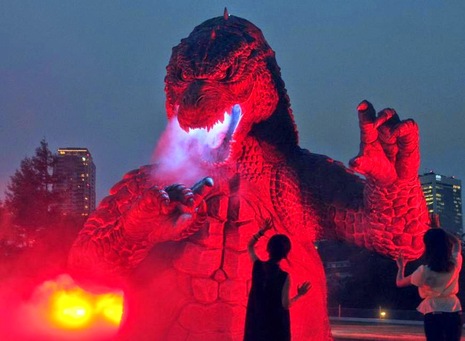Six long decades have passed since the original release of Gojira (Honda, 1954), yielding 29 additional movies. The most recent film, Godzilla (Edwards, 2014), was only just released in May. This unprecedented legacy makes Godzilla not only the longest running franchise in cinematic history, but the most prolific as well. Today, Japan reveres the monster as a national treasure. Tokyo is home to multiple statues erected in tribute to the “King of the Monsters”, one standing over 20 feet tall. In America, Godzilla is one of the precious few fictional characters honored with a star on the Hollywood Walk of Fame. It costarred alongside Charles Barkley in Nike ads. At the 1996 MTV Movie Awards, Patrick Stewart even presented the monster with a Lifetime Achievement Award. It is almost impossible to overstate the cultural impact that Godzilla has wrought, as the creature’s influence continues to resound across geographic and generational divides.
Unlike their western counterparts, Japanese monsters tend to have a great deal more meaning attached to them. They are avatars of far more specific concepts than generic fears of the unknown. This is perhaps never better illustrated then in their own movies, when the military inevitably comes to realize that humanity's weapons are useless against the beasts. There are no silver bullets or cloves of garlic that will ward off Godzilla. A few meager biplanes would not dislodge him from a perch atop the Empire State Building and, unlike Jason Vorhees, Godzilla is not content to exclusively hunt down deviant teenagers in secluded, woodland cabins. No, in every portrayal Godzilla is an unstoppable behemoth. And its wrath is nothing short of apocalyptic.
It is that precise element which grants the franchise its universal appeal. One has only to look at Godzilla, towering over miniature skyscrapers, to recognize the creature’s role within its mythology. Godzilla is not merely big. Godzilla is the biggest presence within its narrative, eclipsing even its own world. In all 30 Godzilla movies, there has yet to be one feature where Godzilla was the main character. Godzilla is instead an omnipotent, omnipresent force, around which the actual characters must perpetually navigate.
In the wake of the Cold War, the threat of nuclear annihilation had become a grim, but consistent, part of 20th century life. Additionally, events like the incident at Three Mile Island had greatly soured the public's opinion of nuclear energy. The atom had become something of an antihero, as its benefits were increasingly dwarfed by its enormous, and terrifying costs. Atomic power had become a double-edged sword, a poisonous necessity for millions who used it to sustain their daily lives. Once again, Godzilla’s nature mutated to reflect these contemporary attitudes.
Throughout the 1990’s and the early 2000’s, Godzilla was depicted as a mostly ambivalent force. No longer the vindictive destroyer of cities, nor humanity’s savior, he became something akin to a hurricane: a great, uncaring storm that would indiscriminately obliterate anything in its path, despite whatever safeguards Japan might put in place. Godzilla continued to occasionally save humankind from all manner of malevolent abominations, but its actions were never spurred on by any sense of altruism, and always ended with ludicrous amounts of collateral damage. Humanity was once again at odds with Godzilla, constantly struggling to devise new means to halt the monster's destruction.
Godzilla may have originally been imagined as the embodiment of war, but in 2014, the creature unarguably represents an even-more universal concept: Supreme Power. Whether battling Japan’s military or golden, three-headed, time-traveling space dragons, Godzilla always endures. There is no power that can dethrone the King of the Monsters. Godzilla is the great equalizer. When audiences see crowds of terrified civilians fleeing Tokyo, they see CEO’s in solidarity with vagrants, lifelong enemies setting aside their differences so that they may feud another day, and governments reaching across political divides to desperately try to survive a common threat. Cowering under Godzilla's looming shadow, all are humbled and laid low. Be it in 1954 or 2014, audiences the world over have beheld the great beast and marveled at the terrifying truth it represents:
"History shows again and again
How nature points up the folly of men."
-Blue Oyster Cult, Godzilla









 RSS Feed
RSS Feed
